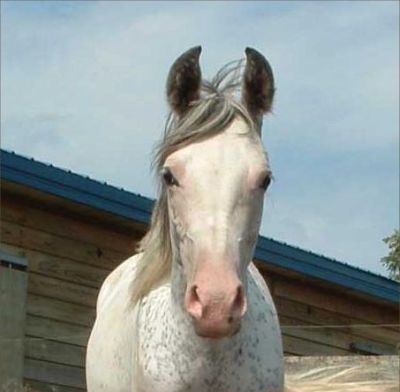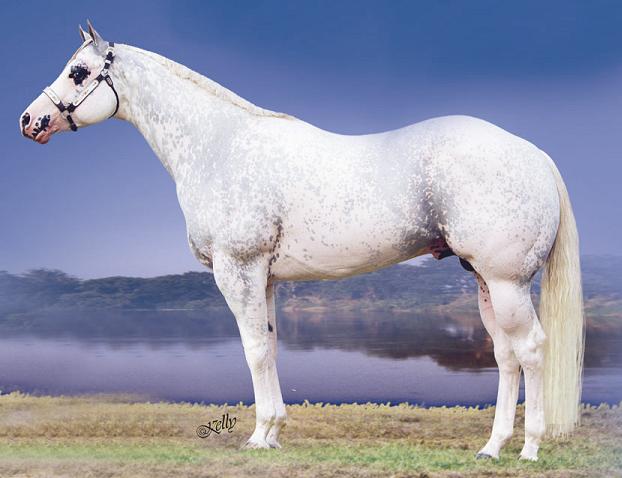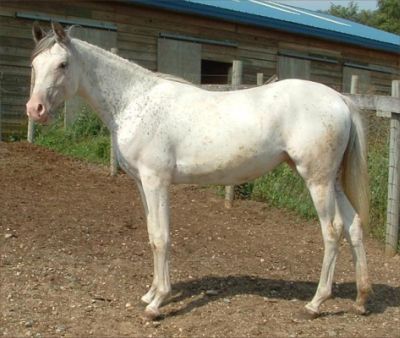dominant white






In contrast to grey horses, white horses are born white, or mostly white. In some breeds it’s thought that dominant white is associated with variable expressivity. The coat can be completely white, or partially pigmented (Haase et al, 2007). Pigmentation usually reduces or completely disappears within the first two years. Dominant white occurs rarely in Tennessee Walking Horses, American Albinos, American Miniatures, Standardbreds, American Quarter Horses, Thoroughbreds and Arabs. It has apparently originated independently on several occasions in Thoroughbreds, and other breeds too. In White Franches-Montagnes horses are known to trace back to the white founder mare Cigale, born in 1957 (Mau et al, 2004). Camarillo White Horses trace to the white founder stallion Sultan, born in 1911 or 1912 (CWHA, 2009). White American Quarter Horses trace back recently to GQ Santana, a picture of whom can be found on this site.
Dominant White mutations are in the KIT geneMau et al (2004) suggested that the KIT gene encodes the white locus, based on the position and known functions of this gene. Haase et al (2007) sequenced the KIT gene in white and non-white Franches-Montagnes Horses. They found a mutation that inactivates the KIT gene product and leads to a lack of melanocytes in the skin of white horses. When they analyzed white horses from other breeds they found three other different KIT gene mutations in white Thoroughbreds, Arabians, and Camarillo White Horses. This shows that independent mutation events in the KIT gene are leading to white coat colour in different horse populations. It is possible that other undescribed mutations exist at the KIT locus.
KIT mutations in other animals are associated with pigment dilution, piebaldness, anaemia, sterility, tumours and some types of leukaemia (Haase et al, 2007). A complete loss of KIT function causes death, either before or just after birth, due to anaemia (Rönnstrand, 2004). It is possible that some KIT mutations are homozygous lethal, it is now thought that this is true for some, but perhaps not all of the dominant white mutations in horses. Some current research (still in progress) is looking at the positions of KIT mutations in mice and correlating the effects with what is seen in horses. If some of the alleles in horses are homozygous lethal, one hopes there will eventually be confirmation (or otherwise), leading to tests becoming available. Interestingly roan, sabino-1 and tobiano have all been independently mapped to the KIT gene region on Chromosome 3 (Marklund et al, 1996, Mau et al, 2004, Brooks and Bailey, 2006, Brooks et al, 2007). The roan allele has been reported to be homozygous lethal in some horse breeds (Hintz and van Vleck, 1979), but thought not to be in others. Having talked to a researcher friend of mine I am of the opinion that this will turn out to be the case. The fact that there are strongly entrenched opinions among breeders on both sides, and in different parts of the World, also leads me to think that maybe both sides could be right, but neither has realised it yet. Perhaps the sequence determination of roan alleles will soon lead to a defintive answer either way.
Different Dominant White Mutations Occur in Different Breeds and Lines
References for dominant white, sabino white and KIT mutationsBrooks, S.A. 2006. Studies of genetic variation at the KIT locus and white spotting patterns in the horse. Ph.D. dissertation, University of Kentucky.
Brooks SA, Bailey E. 2006. Exon skipping in the KIT gene causes a sabino spotting pattern in horses. Mamm Genome 16: 893–902.
Brooks, S., Lear, T., Adelson, D. and Bailey, E. 2007. A chromosome inversion near the KIT gene and the Tobiano spotting pattern in horses. Cytogenetic and Genome Research 119(3-4), 225-230.
Camarillo White Horse Association. Accessed 23 February 2009. http://www.camarillowhitehorses.org/history_camarillo_white_horses.html Castle, Nancy. 2009. Equine KIT Gene Mutations. ~Dominant White & Sabino ~ http://www.duncentralstation.com/PDF/KITGeneMutations-Castle.pdf Castle, WE. 1954. Coat Color Inheritance in Horses and Other Mammals. Genetics 39:33-44.
Cattanach, B.M., 1999. The Dalmatian dilemma: white coat colour and deafness. J. Small Anim. Pract. 40, 193–200.
Gower, Jeanette. 2000. Horse Colour Explained. A breeders perspective. The Crowood Press. ISBN 1 86126 384 8.
Haase, B., Brooks, SA, Schlumbaum, A., Azor, P.J., Bailey, E., Alaeddine, F., Mevissen, M., Burger, D., Poncet, P., Rieder, S., and Leeb, T. 2007. Allelic Heterogeneity at the Equine KIT Locus in Dominant White (W) Horses. PLOS Genetics. http://www.pubmedcentral.nih.gov/picrender.fcgi?artid=2065884&blobtype=pdf
Haase, B., Brooks, SA, Tozaki, T, Burger, D., Poncet, P., Rieder, S., Hasegawa, T., Penedo, C. and Leeb, T. 2009. Seven novel KIT mutations in horses with white coat colour phenotypes. Animal Genetics. http://www3.interscience.wiley.com/journal/122386234/abstract Hintz, HF and van Vleck, LD. 1979. Lethal dominant roan in horses. J Hered 70: 145–146.
Marklund S, Moller MJ, Sandberg K, Andersson L. 1996. Close association between sequence polymorphism in the KIT gene and the roan coat color in horses. Mammalian Genome 10: 283–288.
Mau C, Poncet PA, Bucher B, Stranzinger G, Rieder S (2004) Genetic mapping of dominant white (W), a homozygous lethal condition in the horse (Equus caballus). J Anim Breed Genet 121: 374–383.
Pulos, WL and Hutt, FB. 1969. Lethal dominant white in horses. J Hered 60: 59–63.
Rönnstrand, L. 2004. Signal transduction via the stem cell factor receptor/c-Kit. Cell Mol Life Sci 61: 2535–2548.
Roskoski R Jr. 2005. Signaling by Kit protein-tyrosine kinase–the stem cell factor receptor. Biochem Biophys Res Commun 337: 1–13.
|
|









